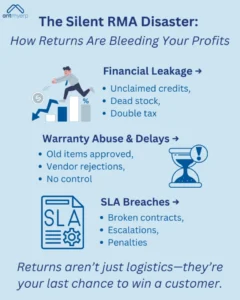RMA Management Software: Stop Profit Loss & Dead Stock
2025-08-15
The RMA Management Software Blackhole: Why Your Service Workflow is Bleeding Profits
“The service was great… until the return process started.”
In business, first impressions win the customer. But it’s the return experience that determines whether they ever come back.
And yet, for thousands of services driven MSMEs and hardware businesses, there’s a blackhole that swallows:
Time
Trust
Revenue
It’s called RMA: Return Merchandise Authorization.
And if you’re not treating it as a strategic workflow, you’re leaving lakhs on the table every year and missing out on opportunities for dead stock prevention before it cripples your cash flow.
The RMA Process Blackhole: What It Looks Like in Real-Life Return Management Systems
Customer: “Sir, I returned the printer two weeks ago. Kya update hai?”
Service team: “We’ll check with the warehouse.”
Warehouse: “We didn’t get any ticket number.”
Sound familiar?
Here’s what happens in broken RMA flows:
- Products come in with no serial or warranty validation
- No automated ticket or SLA tied to return
- Stocking errors at warehouses leading to dead stock
- Refunds/credits delayed or duplicated
- Internal teams fight. Customers churn.
According to Forrester, 63% of customers won’t return to a brand after a bad return experience.
Why Return Material Authorization (RMA) Management Systems Can Destroy Your Business Silently

Financial Leakage in Product Returns Workflow
Lost or untracked RMAs =
- Unclaimed vendor credits
- Dead stock
- Double taxation or over credited invoices
Warranty Abuse and Repair Approval Delays
Without serial number validation,
- Old, out of warranty items get approved
- Vendors reject claims
- No controls in place to prevent warranty abuse means repeat losses in your management system
SLA Breaches Reduce Customer Satisfaction
Untracked RMA timelines equal to
- Broken service contracts
- Escalations
- Penalty clauses triggered
In a service economy, returns management software is not a side process it’s the brand’s closing pitch to improve customer satisfaction.
The Fix: Treat RMA Software as the Brain of Your Return Management Workflow
Just like the brain tracks your body’s signals, your RMA management software must connect to every part of your management solution:
- Service Ticket
- Serial Number
- Warranty Period
- Device Health
- Vendor Return Cycle
- Credit Note or Replacement Approval
An intelligent cloud-based RMA system should:
- Auto-create a return ticket on delivery or service failure
- Validate warranty in real-time
- Assign SLA based on product category or contract
- Track item returns until refund/replacement is complete
- Sync material management, invoice, and support history for traceability
- Maintain full visibility of the service to return cycle to ensure nothing slips through the cracks
According to Gartner, businesses with connected service + return flows reduce churn by 28%.
How AntMyERP’s Best RMA Management Software Improves Customer Satisfaction
AntMyERP isn’t just a management system it’s your customizable RMA software for manufacturers, OEMs, B2B, B2C, and ecommerce brands.
With AntMyERP, you can:
- Link every RMA to a ticket, device, and invoice in your product returns management system
- Define SLA by product, client, or contract
- Trigger vendor approval automatically
- Track return status in real-time
- Generate credit notes or replacements with one click
- Proactively prevent warranty abuse and eliminate unnecessary item returns
- Use built in work instructions to streamline repair processes
No more “check with accounts” or “follow up with vendor” loops.
Real-World Use Case: 48 Hours to Loyalty with Cloud Based Returns Management Software
A medical device rental firm in Bengaluru switched to Rentovi RMA.
- Return tickets auto created from failed installation tickets
- Replacement units dispatched within 24 hours
- Refunds tracked and synced with Zoho Books for traceability
Customer satisfaction improved, churn dropped 21% in one quarter and enhanced quality management ensured dead stock prevention and smoother service to return cycles.

